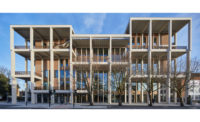Grafton Architects Returns to Kingston University London for New Project Following 2021 Stirling Prize Win

Grafton Architects co-founders Shelley McNamara (left) and partner Yvonne Farrell (right). Image courtesy Grafton Architects
Architects & Firms
Grafton Architects, the Dublin-based firm lead by 2020 Pritzker Prize laureates Yvonne Farrell and Shelley McNamara, has been selected for its second project at Kingston University London following its surprise 2021 Royal Institute of British Architects (RIBA) Stirling Prize win for the school’s Town House building. That project, a mixed-use higher education building defined by its precast concrete frame, soaring colonnaded facade, and wealth of social spaces, was also winner of the 2022 European Union Prize for Contemporary Architecture–the Mies van der Rohe Award. (A somewhat bittersweet triumph as the final win for a United Kingdom–based project in terms of eligibility due to Brexit; Town House was also Grafton’s inaugural completed project in the UK.)
For Grafton’s return to Kingston University, the firm will develop an initial design concept for a new building and landscape upgrades at Middle Mill, a student housing–anchored complex adjacent to the Knight’s Park campus. Situated along the Hogsmill River in the southwest suburbs of London, Knight’s Park—one of four campuses that comprise Kingston University–is home to Kingston School of Art, including its architecture department. The forthcoming building and the firm’s much-heralded prior commission for Kingston won’t exactly be neighbors. Town House, completed in 2020, is located at the Penrhyn Road campus, less than a half-mile across the river from the Middle Mill site.
Grafton won the project out of a closely watched two-phase competition organized by RIBA and the university; fellow shortlisted firms included Caruso St John Architects, Haworth Tompkins (also both Stirling winners), Carmody Groarke, Hall McKnight, and Reiach and Hall. Kingston vice-chancellor Steven Spier said in a statement that the firm’s “inspiring early vision for Middle Mill supports our commitment to developing our students’ future skills and increasing the University's influence and impact at the highest levels nationally.”
Poised to include a 200-seat lecture hall, exhibition space, offices, and more, the new building will dramatically increase the amount of studio space and technical support facilities for the Kingston School of Art while planned public realm improvements will help to further meld Middle Mill with the surrounding riparian landscape.
The site’s location along a tributary of the Thames has shaped Grafton’s early design concept.
“We see the river as a thread binding the campus together, joining Knights Park to a new building,” McNamara explained. “The proximity of the life of the river and the life of the building will be there together, of equal status.”
“Architecture has a real role to play in heightening awareness of where people are on the planet, while we often liken education to a flowing, sharing river,” Farrell added.
Per the university, the Grafton team will begin devising its primary design concept before “extensive engagement” commences with students, faculty, neighbors, and the greater community in hopes that the revamped riverside site will emerge as an "asset" for the borough of Kingston upon Thames.
The project could be completed as soon as the 2029–30 academic year provided there are no bureaucratic holdups.
“We want to design something that capitalizes on and emphasizes what the University has to offer already and that is equally full of hope for a sustainable future for generations to come,” said Farrell. “We also want to create a threshold that is soft, welcoming and inviting to reflect the importance the University places on its outreach with the wider community.”
Outside of London, Grafton Architects–helmed higher education projects currently underway include the under-construction Anthony Timberlands Center for Design and Materials Innovation at the University of Arkansas, which marks not only the Irish firm’s first timber building but also its first in the U.S.




